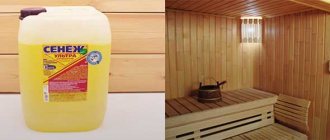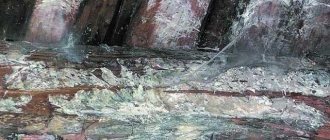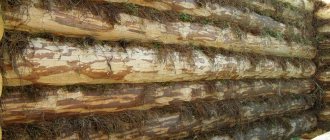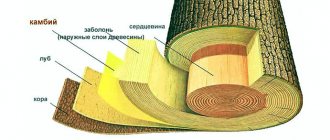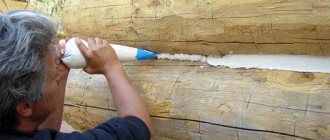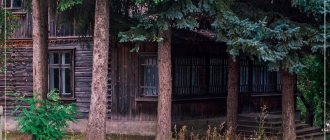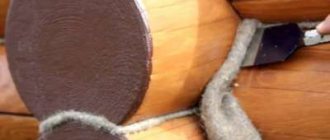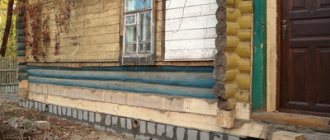A wooden residential building often suffers from various kinds of misfortunes. Harmful underfloor fungus is one of the most common problems plaguing the lives of homeowners. The spread of fungus in the house usually begins in the basement or cellar.
Content:
- A little about mold
- Black mold
- Harm from household mold on walls
- Causes of mold on the walls of the house and its elimination
- How to get rid of mold in a wooden house
- Eliminating the causes of mold
- How to prevent mold from reoccurring
- Folk remedies for mold control
- Copper or iron sulfate
- Sulfur checker
- Warmer
- Substances containing chlorine
- Recommendations for treating surfaces affected by fungus
- Video on mold in a wooden house
Wooden walls are not only susceptible to the destructive effects of moisture and are an excellent environment for pests, but are also prone to mold. Most often, it becomes an unpleasant surprise and appears in areas with high levels of dampness and moisture, poorly lit corners and in rooms where there is poor or no air exchange. Typically, these are parts of the walls adjacent to the foundation, basement and basement levels.
Causes of fungus
Methods for dealing with fungus in a wooden house will be useful not only for people who live in a private house and in damp or swampy areas. Sometimes in apartments fungus can appear, at first glance, out of nowhere.
Many people ignore the presence of an unpleasant smell or black corners in the room and simply re-stick the wallpaper or re-lay the floor. Damp green or blackened basement walls do not interfere with food storage. And the appearance of shortness of breath, headaches and other diseases is mainly attributed to the weather or age.
In order to prevent the fungus from spoiling the health and decoration of the room, it is better to prevent its appearance in the house. It's much easier than dealing with the consequences. To avoid harmful spores in your home, you should know the reasons for their occurrence.
The main reason that fungus has appeared in the house and you are thinking about how to get rid of it is moisture from the ground or high humidity in the underground covering:
- Dampness penetrates the floor covering and infects the walls with fungus.
- Damp apartments on the first floors of multi-story buildings are an excellent habitat for toxic mold spores.
- Insufficient room ventilation contributes to the appearance of dampness.
- Growing many indoor plants in small spaces that require constant humidity.
- Improper use of humidifiers is also a cause of mold.
A little about mold
Mold in a wooden house is the simplest microorganisms that very quickly unite into numerous colonies, which quickly become visible to the human eye.
If there are several types of mold - wood-staining, which destroys wood and causes harm to humans, and wood-destroying - which does not have a negative effect on people, but contributes to the rapid destruction of walls. In case of large lesions, the house is usually designated for demolition.
The most poisonous mold is yellow. It releases substances that, in some cases, lead to the formation of tumors.
Black mold
If you don’t look closely, you might think that a black coating is just ingrained dirt that can be easily wiped off. However, these are colonies of microscopic fungi that are extremely dangerous to human health. They appear in places of high humidity - in swimming pools, bathrooms, bathrooms, kitchens. This scourge affects air purifiers, starts up in washing machines and air conditioners, and clings between tiles. Fungal spores quickly enter the body through the respiratory tract, into the trachea, bronchi, and alveoli, leading to various diseases and necrosis. Growing rapidly and releasing large amounts of toxins, microorganisms can cause suffocation and even death.
Harm from household mold on walls
When mold and mildew appear in a home, not only wood surfaces, but also human health are negatively affected. Therefore, if such a problem is identified, you should immediately move on to solving it. Spores enter the human body by air, causing various diseases of the respiratory tract, skin, and even lead to the development of bronchial asthma. As the fungus divides and multiplies, it releases substances that not only can cause serious health problems, but also emit an unpleasant odor that wafts throughout the home.
Children and adults with weak immune systems are susceptible to the negative effects of mold. It can cause nausea, migraines and loss of energy.
How does it manifest?
In addition to the obvious symptoms of hyperhidrosis of the arms or legs, there are others. For example, the hands and soles feel cold and sticky to the touch. The skin on them is slightly reddened, the lines and furrows are clear and deep.
In people suffering from excessive sweating, embarrassment, withdrawal, and embarrassment are noticeable from the outside. They are afraid to extend their hand to shake hands, afraid of close physical contact, and have difficulty holding slippery objects.
Increased secretion often leads to irritation, inflammation of the skin, and infection. Common complications of hyperhidrosis on the feet include fungal infections of the skin and nails.
Causes of mold on the walls of the house and its elimination
Mold spores are constantly in the air. They can wait a long time for the emergence of a favorable environment and a suitable surface for settling and beginning to reproduce. Wet wood is the best conditions for the development of fungus. It takes root at lightning speed on the surface, sprouting with the thinnest threads and forming whole foci of brown-black color. If measures are not immediately taken to remove them, mold will soon cover all wooden surfaces in the house, making it uninhabitable.
From the above it follows that the main cause of mold is high humidity. As for the ambient temperature, many types of this “disease” of the wood surface can exist and develop at 0 degrees and sub-zero temperatures. This is why we can often see basement walls covered with black stains and emitting a stench even in the winter season.
Another reason contributing to the appearance of fungus is improperly organized insulation and ventilation of rooms, as a result of which condensation accumulates on the walls. You can notice this quickly - by fogged windows, where the accumulation of steam is better visible.
Normal humidity is 70-80 percent. If this indicator is higher, due to excessively darkened rooms, an abundance of plants, frequent washing or other reasons, the liquid concentrates in certain places and leads to the formation of fungus.
Types of mold and mildew of wood
Both terms refer to the same group of organisms. Mold is the same fungal culture, only with homogeneous, small fruits.
Depending on the effect on living organisms, it can be:
- allergenic - irritates the immune system, causing a wide range of reactions: from skin rashes to asthma attacks;
- pathogenic - worsens the course of acute diseases existing in a person;
- toxicogenic - produces toxic compounds that can lead to dangerous and even fatal conditions.
All three types of fungus can appear on a tree. Walls, floors and other surfaces are affected by:
- Aureobasidium is an allergenic mold. Found on painted wood structures. Colonies are pinkish, brown or black. A darker shade indicates greater age. In direct contact with skin the species often causes dermatitis. It can also cause eye and nail infections.
- Trichoderma lignorum is a soil fungus. It grows in a humid environment and produces mycotoxins that are destructive to wood. May cause allergies and respiratory problems. Appears as white fleecy formations with green spots.
- Stachysbotrys - Known as "black mold". The fungus forms on cellulose structures: boards, cardboard or wickerwork. The toxins produced by the species lead to inflammation of the respiratory tract, depression, nosebleeds and neurological disorders. They are especially dangerous for children.
- Penicillium - spreads throughout the wood in the form of a greenish or white network.
- Rot is a lesion caused by various fungi that break down cellulose fibers. It happens brown when during the growth process it releases hydrogen peroxide, which promotes the decomposition of the material. The wood becomes brittle and the color changes to brown. Pathogens of soft rot provoke the formation of microscopic cavities in the material, reducing its strength. The tree becomes discolored. The mold that causes white rot breaks down lignin, one of the structural components of plant cells. The fungus grows in light fibers.
- Cladosporium - usually appears on the leaves as dark, dry spots. May be found on wooden furniture and trim.
- House mushroom or Serpula Lacrymans is more dangerous for the material than for humans. Wood is the main food source of the species. The fungus gradually destroys it, causing dry rot. A characteristic feature of such a parasite is its yellow color.
Interesting! Mold enters the home on clothes and purchases. Its source can be a New Year tree.
Indoors, the appearance of fungus is facilitated by poor ventilation, high humidity and stable temperature. Mold on boards often forms in the crawl space or on the kitchen ceiling in nooks and crannies near hanging cabinets. It also appears on external structures.
How to get rid of mold in a wooden house
Simply removing mold from the walls is not enough - the results will not last long and the problem will soon return. The correct technology for removing mold is to first eliminate its cause: waterproof the basement, ensure effective ventilation, allocate funds for insulation and create an optimal heating system.
Eliminating the causes of mold
One of the main points when building a house, which specialists always pay attention to, is the mandatory coating of the surface of the wood used in construction with special antiseptic substances that prevent the appearance of fungal formations. Walls should be treated with similar products once every certain period, usually indicated on the packaging. To start using drugs that have antifungal effects, you first need to:
- Sand problem surfaces using sandpaper or using a grinder.
- If possible, replace the affected part altogether.
- If the wood is damp, it must be dried by additional heating or ventilation of the room.
- Then, the product is applied to the surface with a brush or roller, penetrating deep into the timber and destroying the pores of mold.
- After some time, it is recommended to repeat the procedure.
Please note that along with other products, preventive liquids are sold in stores - they will not suit you if you need to get rid of fungus. Carefully read the instructions for use and clearly explain to the seller what is required, otherwise you risk buying an ineffective product, wasting time in the fight against mold in a wooden house and wasting money.
It is also better to treat not only areas with mold with mixtures, but entire walls.
Useful expert advice
By the way, keep in mind that glass, metal, hard plastic and other non-porous surfaces can be treated with Neomid and used again - after you have completely cleaned visible mold from the surface.
But it is better to get rid of contaminated porous materials - drywall, carpets, books. Because mold is almost impossible to remove from them.
Photo: a large volume of logs, as a rule, this is a wooden frame of a residential building for permanent residence. This requires a professional approach when destroying house fungus.
If you need to treat a large area against fungus, then it is advisable to seal the room to prevent the spread of house fungus to the rest of the wooden house, log house, log bathhouse .
To reduce the release of dry spores into the air, dampen the dry area of the mold. Use a sprayer to apply Neomid 500 or a brush well soaked in the solution.
After removing mold and disinfecting surfaces, allow them to dry completely. And then be sure to treat with Neomid 440 and Neomid 430, which will prevent the recurrence of fungus.
Once everything is completely treated, clean the room using a filter vacuum to remove any remaining spores and mold.
It can be recommended to treat all surfaces with a potential risk of fungal infection with Neomid as a preventative measure.
Photo: we must not forget that the main carrier of infection of wooden structures with house fungus is the bark beetle. This is a very dangerous bug. Not only does it eat the tree, the beetle is also a carrier of various fungal infections.
Photo: Neomid protective products can be considered one of the best drugs in the fight against house fungus and other wood damage.
How to prevent mold from reoccurring
To prevent mold from settling on the walls of your home again, you should follow certain rules:
- ventilate the room more often;
- do not place furniture close to the wall, leave at least a minimum gap to ensure air passage;
- the drainage system should be organized in such a way that melt and rainwater do not flow down the walls;
- the façade of the house is also hydrophobic;
- use preventive measures;
- leave a small distance between the wall and thermal insulation materials.
Please note that if your neighbors’ houses are infected with mold or have noticeable cracks, the problem can quickly spread to you. Warn her by following all the above rules.
Prevention measures
After the fungus in the cellar is destroyed, care must be taken to ensure that it does not reappear. Preventive measures will help with this.
- Insulate the building and install waterproofing.
- Make it a rule to regularly inspect rooms where excess dampness may appear, paying special attention to corners, joints and places where sunlight does not penetrate or is extremely rare.
- Ventilate the basement, avoid dampness.
- Treat all surfaces, both wooden and other materials, with a fungicidal antiseptic.
If you are in the process of construction, listen to the advice and take care in advance to prevent fungus from settling in the house.
- A ventilation device will avoid problems with dampness. If it is impossible to design a supply and exhaust system, at least make windows for ventilation. It would be good if sunlight would also penetrate through them.
- Insulate the foundation and waterproof the basement and subfloor.
- Building materials should be treated with an antiseptic.
- It would be good if heating was provided in the basement.
Folk remedies for mold control
If store branded antiseptics are unaffordable or there is nowhere to buy them, all that remains is to fight the mold yourself, using time-tested means.
Boric acid is also effective against fungal deposits. In a 10-liter bucket of water, dilute 400 grams of acid with a kilogram of borax and one and a half liters of vinegar. The main condition due to which a good result is achieved is preheating the mixture to 70 degrees and then spraying it on the walls.
You can also apply a protective layer of oil or resin - they prevent spores from penetrating deep into the wood.
Boric acid can also be used in combination with salt in the proportion per 100 grams of solution - 2 kg of certified salt.
In addition, various chemicals are used as antifungal agents:
- Treat the walls with hydrogen peroxide and wipe with a damp cloth after 10-15 minutes. Sometimes it is mixed with vinegar to enhance the effect;
- a mixture of laundry soap and urine;
- a solution of water and office glue;
- ammonia;
- coating the surface with drying oil.
Destruction of fungus: step-by-step instructions
First of all, you need to vacate the premises. Leave clean shoes and clothes outside the mold-affected area to avoid spreading mold spores throughout your home or apartment.
Remove all household items from the premises. Undamaged items should be moved to a clean place, and damaged items should be placed in trash bags. Garbage bags should be sealed and thrown away.
Place washable rugs, furniture and clothing in the sun. They will need to be processed later. Seal the room affected by the fungus by covering the doors with thick film. The film must be glued with tape or nailed. Open a window in the room for ventilation. Place a fan on the windowsill in the affected room and turn it on. The fan can also be placed on the floor, pointing it towards the window. Avoid pointing the fan at fungus-affected areas to prevent spores from becoming airborne.
Remove the floor covering from the affected area. Sometimes rooms have an intermediate baseboard. It also needs to be removed. Remove all floor coverings. If you are completely sure that the fungus has affected only a small area of the floor, then you can open only it and about 50-70 cm around the circumference next to it. If mold is found elsewhere, more covering will have to be removed.
If there is parquet or similar covering on the floor in the room, start removing it from the corner of the room. If the room is upholstered in carpet, then it needs to be torn off along with the padding from the boards. Score the linoleum with a staple and sand it down.
Wet the areas affected by mold with water to prevent it from escaping. Linoleum, carpet and similar coverings must be thrown away. Carefully inspect the wood flooring or parquet board. If there are no traces of fungus on them, you can put them aside while you treat mold-affected areas.
Sulfur checker
If you don’t know how to get rid of mold in the basement of a wooden house, use a sulfur bomb. This is a fine aerosol that, when combined with air, forms a deadly mixture for fungus and its spores. At the same time, the smallest particles easily penetrate the narrowest crevices of wooden surfaces, being an effective way in the fight against mold.
How to destroy fungus step by step
So, having chosen a mold control tactic, the following steps are taken:
- Existing mold must be removed. To do this, you can use soapy water and sandpaper.
- Treat the surface with an antifungal agent.
- Inspect all items, and if mold is found, clean them too. If you can’t clean it (the mold has settled deeply and reliably), then it’s better to throw the thing away.
- The main weapon that will work for the future “future without mold” is to establish good ventilation; you need to organize a constant flow of fresh air.
- Reduce humidity in the basement.
Substances containing chlorine
The sensational and well-known “Domestos” or “whiteness”, other liquids containing chlorine, also help get rid of the scourge. They need to be applied temporarily to wooden surfaces with a dampened cloth or using a spray. The second option will be of better quality, since the smallest particles will better penetrate into cracks, chips and irregularities. Do not dilute the products with water - the concentrated version will deal with mold better. After some time it will begin to lighten, after which it will disappear completely. Do not wipe the walls; let them dry naturally.
Types of fungus
If fungus occurs in the house, not everyone knows its consequences and how to deal with it. And at the same time, any type of fungus is very dangerous for wood products. They contribute to the destruction of wood fibers. As a result, if harmful formations are not eliminated in a timely manner, a house made of wood may completely collapse to the very foundation. Fungal spores can spread through the air or be carried on clothing or animal fur.
Important! In ancient times, buildings infected with this kind of pest were burned to protect other buildings from being affected by this “disease.”
White house mushroom
It contributes to the destruction of the wood structure, changes in its color and the appearance of cracks.
Blue fungi
When such formations appear, the wood acquires a gray-blue tint. Bacteria destroy varnish and paint. Thus, moisture gets inside the products.
Rotting fungi
There are wet and dry rot:
- Wet damages damp wood that is near the ground or drainpipes. Affected products become loose and dark lines form on them.
- Dry, in turn, manifests itself as reddish dust in the corners and multiplies quickly in a humid environment. Gray stripes appear on the tree, destroying the wood fibers.
White and black mold
This type of microorganisms can form not only on wooden surfaces. Stone, concrete tiles and various fabrics can become a place for the emergence and active reproduction of fungus. In addition to its destructive effect on various materials, mold is very harmful to human and animal health. Therefore, if a fungus appears in the house, its consequences and how to deal with it still need to be clarified, and as quickly as possible.
Recommendations for treating surfaces affected by fungus
When using store-bought and homemade antiseptics, use personal protective equipment and take care of your eyes and respiratory organs. At the time of treatment, it is better for the residents to leave the premises altogether.
Mold most often eats deep into the wood and sometimes there is nothing left but to cut down and remove the affected area; there are also cases when the house can no longer be restored. It is better, when a problem is discovered, to entrust its solution to professionals who will not only select the optimal remedy, but also guarantee the quality of the measures taken and the result.
The appearance of mold is a signal that certain processes in the house are not going as they should and mistakes were made somewhere during construction. It is not recommended to ignore a problem that significantly affects wall surfaces and human health. The sooner you find an effective remedy, the larger the area of the wooden house you will be able to save. It is better not to wait for fungus to appear - regularly treat the surface with preventative agents, cover it with protective substances, and then your wooden house will not be subject to fungal plaque.
Prevention is the basis of wood integrity and human health
To reduce the risk of mold development on wooden structures, use the following expert advice:
Protect wood with special coatings that not only suppress the growth of pathogenic flora, but also prevent it from swelling under high humidity.- Ensure good ventilation in enclosed areas to prevent warm, moist air from accumulating.
- Provide access to sunlight from enclosed spaces. If it is not possible to open the windows, use UV lamps that are turned on periodically.
- Inspect surfaces several times a year for mold.
- Treat wood annually with special disinfectants, since the structure of this material is a good place for the development of fungus.
You should not ignore the treatment of the facades of residential buildings with special means. Just a few hours a year will help your wood last longer, eliminating the risk of contact with harmful bacteria.
